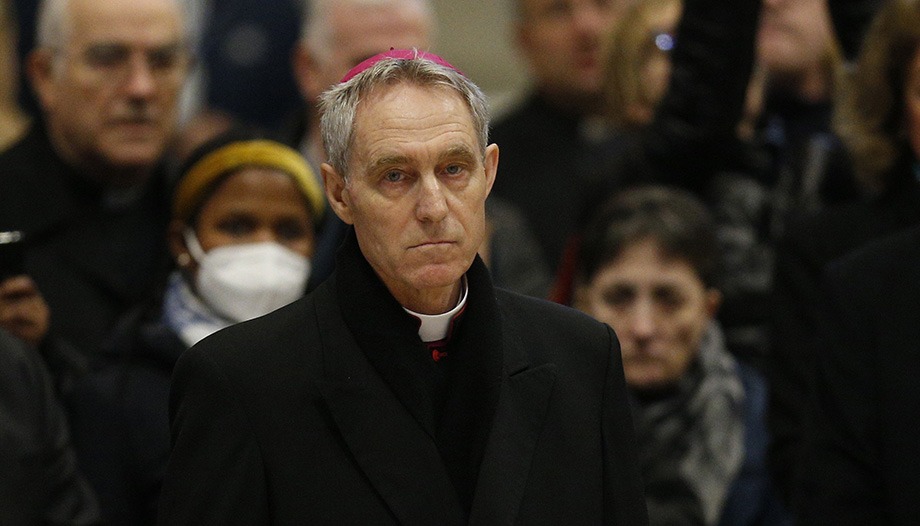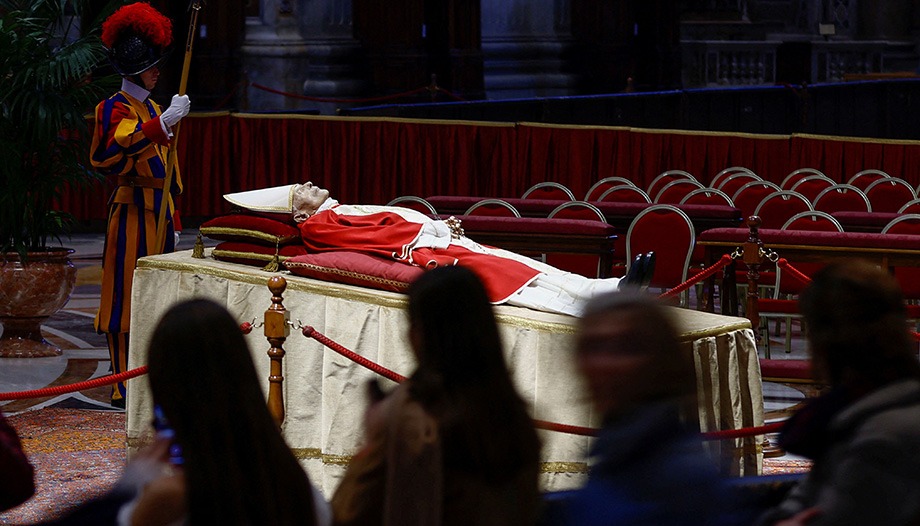It has been an intense day, the first of the days in which it has been possible to pay a last homage and prayer to Benedict XVI in the Vatican Basilica.
The transfer of the mortal remains of Benedict XVI to St. Peter's Basilica took place at 7:00 a.m. this morning, and the arrival at the Basilica was at 7:15 a.m. The brief rite was presided over by Card. The brief rite was presided over by Card. Gambetti, which lasted until 7:40.
The Basilica was then prepared for the arrival of the faithful who visited the Pope Emeritus. From the beginning, at 9:00 a.m., when the Basilica was opened, and throughout Monday, there was always a sense of calm in the queues, without many selfies, with recollection.
The first images of the mortal remains of Benedict XVI have raised some comments among the faithful and pilgrims. When John Paul II died in 2005, he did not wear a miter or crozier when he rested in his private chapel. While Benedict did.
One of the great doubts of an unprecedented event such as the death of an emeritus pontiff was the funeral rite and the protocol that would be established.
The clothing provides some clues, since Benedict XVI was dressed in papal red, but without the pallium: the ornament that is placed around the neck and that indicates the power exercised at the moment of his death. The absence of the pallium indicates that the German had just retired. Benedict XVI was clothed in red pontifical vestments, the color reserved for pontiffs. He wears a solemn red chasuble and a miter with golden borders.
As he renounced to be pontiff, he also does not wear the "pastoral cross", the cane topped with a cross that has a meaning parallel to that of the pallium. Nor does he wear burgundy-colored shoes, which in papal tradition evoke the blood shed by the martyrs following in the footsteps of Christ.
In addition, Benedict is holding an intertwined rosary in his hands. He is leaning on a catafalque covered by a red velvet cloth and supported by two brown cushions. Next to him is a lighted candle. An interesting fact: Pope Emeritus Benedict lies on the altar wearing the chasuble he wore at the closing Mass of the 2008 World Youth Day in Sydney.
Archbishop Ganswein, Pope Benedict's personal secretary, was present at the tomb from the beginning of the morning and received the condolences of numerous personalities throughout the day, beginning with Matarella, President of the Italian Republic, and the Prime Minister, Giorgia Meloni.

Long lines in St. Peter's Square to bid farewell to Benedict XVI
Throughout the day there have been long lines in St. Peter's Square to bid farewell to Benedict XVI.
The incoming and outgoing are crisscrossing and preparations for Thursday's funeral are beginning. We are also in a very special situation, since we did not experience what we did when John Paul II, the reigning Pope, passed away. Benedict XVI has been retired for 10 years, but St. Peter's Square is once again alive and young. We have been able to see many young pilgrims, for whom Benedict XVI was, is and will continue to be a reference in their Christian life. We are before a pope who deeply believed in the power of the Truth, who loved the Truth, who died loving the Truth on his lips.
We begin to count on many reactions after the disappearance of the first "pope emeritus" in history, a pope who has produced an enormous doctrinal work: 3 encyclicals, 275 letters, 125 apostolic constitutions, 4 apostolic exhortations, 67 apostolic letters, 13 Motu proprios, 199 messages, 349 homilies, and about 1500 speeches.
Gathering the impressions of tourists and pilgrims, it is common to hear assessments such as those of an Italian family, originally from Milan, who emphasize (a middle-aged couple) that Benedict was above all an affable person, with a simple and direct eloquence, typical of an extraordinarily educated person, with a rare ability to capture the heart with a concept and an idea".
Not very different is the memory of Mr. Lluís Clavell, former rector of the Pontifical University of the Holy Cross and professor of metaphysics at the same university. "He came to see us twice. Once just to be with us and answer our questions. And from his thoughtful answers you could tell he had a rare ability to listen. To answer first you have to listen well. Ratzinger possessed both qualities.
We were also able to hear on the radio the statements of Cardinal Pell, who confirmed: "Pope Ratzinger was a Christian gentleman. A true German professor, a man of exquisite manners, of high culture, a gentleman of the old school, very, very educated."
Other people in the square said, like the Italian nun Lucia: "I have been here since very early in the morning. I owed it to him to greet him at this moment, after all he has done for the Church. At his side, thousands of people queued all day long to enter the Basilica. Some 35,000 people are expected to visit the chapel every day, which will remain open until Wednesday. Today it has been confirmed that 40,000 people have passed through the Basilica.
The first faithful to enter the basilica were a group of priests from India. The coincidence of Benedict XVI's death with the Christmas vacations meant that many of the onlookers were mere tourists. Like Jennifer K., an American who, together with several friends, emphasized how "lucky" she was to have been in Rome during these days. "I am sad about the death of Benedict XVI, but for us it was a great coincidence that he caught us in Rome, and here we are". Others, like a group of Spaniards a few meters away, took advantage of their vacation trip to attend the funeral. "We do it out of respect for Benedict, although the truth is we haven't known him very well," said Luis Mesa, 36.
For other personalities, such as Sister Alessandra Smerilli, secretary of one of the most important Dicasteries of the Holy See, the testament of Pope Benedict XVI recalls his humble origins, his relationship with his family. A simple testament, simple his life, he remained steadfast before God moment by moment".
Others, like Gustavo Entrala, the Spanish communicator who helped Benedict send his first tweet, have recalled online how he and his team got Pope Benedict XVI on social media. Today, @Pontifex is an undisputed success. And that had its origin with the previous Pope, advised by the Spanish communicator.
According to the Archbishop of Malta, Charles Scicluna, it was Benedict XVI who first began to confront "the dark side" of sexual abuse committed by clerics, promoting a series of measures that today form the core of the Church's "zero tolerance" policy. Before his election to the papacy, then-Cardinal Joseph Ratzinger "played a decisive role in the long process of updating legislation and procedures" to deal with serious crimes such as the sexual abuse of minors, Scicluna said. As both Vatican prefect and pope, Scicluna said, Benedict XVI led the reform "in constant dialogue with canonical experts" and promoted "formation at all levels." During his eight years as pope, Scicluna said, Benedict spent time each week reviewing cases of abusive priests who needed decisions.
In a quick review of Benedict's legacy, which so many remember today, we could mention that "Faith and reason meet again in a new way" and that during his pontificate he repeated many times that man is capable of truth and must search for it. That it needs criteria to be verified and must go hand in hand with real tolerance. The measure of truth for Catholics is the Son of God. With respect to Vatican II, he always remembered "The hermeneutics of the reform". He fought so that the meaning of the Second Vatican Council would be truly understood, as a search for a "synthesis of fidelity and dynamism". In the area of the New Evangelization, he insisted on "Rediscovering the joy of believing": for Benedict, the new evangelization should be charged with finding ways to make the proclamation of salvation more effective, without which personal existence remains contradictory and deprived of what is essential. but he also insisted strongly on the importance of dialogue with everyone. Although Benedict XVI was always firm in his defense of the faith, he sought to smooth out differences and build bridges within and outside the Church. Moved by a desire for unity, he tried to attract those who for one reason or another had turned away from Rome.
Funeral arrangements
Preparations for the solemn funeral of Pope Benedict XVI, scheduled for Thursday the 5th, are in full swing. Joseph Ratzinger's funeral will be that of a Roman Pontiff, with the rites and veneration that the Church has always paid to the successor (Benedict was the 265th) of the Apostle Peter.
Although Vatican protocol, usually very precise and detailed for the farewell of a Pope, is for the first time in its two thousand year history recording the funeral of a Pontiff celebrated by his successor, Pope Francis. And so work is underway to draft new rules.
But what are the Ultima Commendatio and the Valedictiothe blessings that precede the burial? The Latin translation of the first sounds like "the last commendation". As the Roman liturgical ritual prescribes, at the end of the liturgy of the word (i.e., the readings of Bible and Gospel passages, accompanied by hymns, the homily, the profession of faith and the universal or prayer of the faithful) the celebrant with the concelebrants sprinkles the coffin with holy water and incense. This is followed by a prayer, which is usually: "We commit the mortal body of our brother (or sister) to the earth in expectation of his resurrection; may the Lord receive his soul into the glorious communion of saints; may he open the arms of his mercy, so that this our brother, redeemed from death, absolved from all guilt, reconciled with the Father and carried on the shoulders of the Good Shepherd, may share in the eternal glory in the Kingdom of Heaven".
The Valedictio, from the Latin greeting "Vale", which the Romans said or wrote when greeting each other and which is equivalent to our "See you later" with the addition of a wish for health and peace, represents the last farewell to the deceased. The most commonly used is "Come, ye saints of God, make haste, ye angels of the Lord". Receive his soul and present it to the throne of the Most High. May Christ, who has called you, receive you, and may the angels lead you with Abraham to paradise. Receive his soul and present it to the throne of the Most High. Eternal rest grant unto him, O Lord, and let perpetual light shine upon him. Receive his soul and present it to the throne of the Most High'.
The coffin is then taken to the place of burial, which for Pope Ratzinger should be, according to his request, the loculus of the Vatican Grottoes where the body of John Paul II was deposited before being transferred to the upper part of the Basilica.





 Benedict XVI passes away
Benedict XVI passes away





